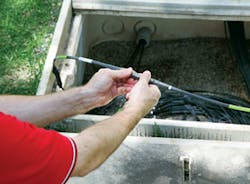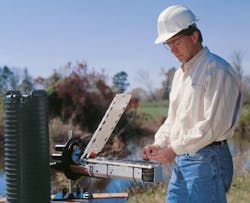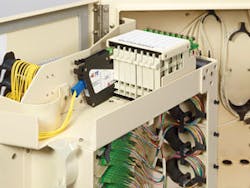Choosing an optimal FTTH architecture
By Erik Gronvall
Fiber-to-the-home (FTTH) deployment is increasing globally, led by the Asia Pacific region, rapid acceptance in Europe, and continuing rollouts in North America. Providers are feeling the pressure like never before to take fiber ever closer to residential and small-business locations. FTTH has emerged as the best option for offering both higher speeds and longer reach -- not to mention peace of mind about future network requirements.
But network architects must make dozens of decisions before they break ground on new deployments and network upgrades to FTTH. These decisions involve splitter locations, connectorization methods, future upgradability, long-term maintenance, and cost (first cost, total cost, operating cost, etc.). Making the right choices is critical to ensure the new infrastructure design aligns as closely as possible with business expectations now and throughout the life of the network.
Although some parameters may overlap during the network planning process, important areas that ultimately drive architecture decisions include geographical location, business case, pre-deployment considerations, and futureproofing. Understanding any unique challenges posed within each of these areas -- such as population densities, required take rates, advantages and disadvantages of connectorization options, or ease of migration to next generation technologies -- will help service providers choose an optimal FTTH architecture.
Once the service provider is clear on where the network is going and what it needs to do, an informed architecture decision is possible. There are many architectures to choose from -- centralized using closures or a fiber distribution hub, cascaded with or without closures, fiber indexing model, fiber reuse model, and any number of hybrid approaches. The correct option might be any one of these architectures or a combination of several. Weighing the benefits, drawbacks, and tradeoffs associated with each FTTH architecture will put service providers on the path to a proper balance of capital and operational cost, time, flexibility, reconfigurability, and overall performance.
Geographical, customer landscape
One obvious consideration is the geographical area the network will serve, particularly for a new deployment. Will the network primarily serve business customers, multidwelling units (MDUs), or single-family homes? Taking fiber to a rural area versus a densely populated environment will present different architectural challenges. Expected take rates must also be factored into the density equation, including any expected future development to the area.
The bandwidth requirements will also vary. In a situation that has both residential and business customers, for example, requirements may vary greatly in terms of availability and peak usage periods. Existing service-level agreements must also be honored for large businesses and institutions like hospitals, schools, government entities, or other large-scale users. Dark fiber applications such as fixed wireless, wireless LAN or WiMax, mobile networks, and key security monitoring devices may be required to serve all the customer needs in one area. The FTTH network may need to connect to some or all of these types of applications.
The physical environment should also be considered for the outside plant portion of the network. For example, in an area where outside temperatures vary considerably, the use of hardened connectors or other hardened products may be required to provide protection from harsh weather (see Figure 1). Is the area prone to flooding, high wind, or other climatic events that may require everything to be in the ground or high above the ground?
In the case of a brownfield or overbuild scenario, much of this customer landscape information will already be available. But in these cases, a re-evaluation with an eye to the future will still help determine the type of architecture upgrade that'll meet both current and future FTTH network requirements.
Meeting business-case expectations
The business case is where the balance between capital expenditures (capex) and operational expenditures (opex) is determined to reach the desired return on investment (ROI). In general, the infrastructure layer of the network has a useful life in the 10--20-year range. Spending more on capex typically reduces opex over time. But there are important issues that determine the overall cost, including speed of installation, ROI expectations, ease of maintenance and, in the case of overbuilds, any reuse of existing infrastructure.
A decision to spend less on capex to achieve a faster ROI, for instance, may be a good decision if the network's life expectancy is relatively short or if it will likely require major changes in the near future. On the other hand, when longevity of the network is a primary concern, spending more on capex may yield a longer ROI but save significant opex over time. In either case, this decision will have a major impact on the architecture choice.
There are also many factors that will influence how quickly the network can be deployed or how long an overbuild or upgrade will take to complete. For example, a completely connectorized network will be in place much faster than an all-spliced network due to the latter's specialized labor requirements and the time required for each splice. This decision also should factor in the availability of skilled labor -- not just in the area of splicing but in general. The speed and scale of broadband growth is putting a strain on the availability of skilled and qualified workers to install networks and turn up services.
Another factor to consider is securing rights-of-way for placing cables or enclosures. As previously mentioned, some areas may need everything underground, including terminals and other enclosures, while some situations may call for aerial cables. Aesthetics are a huge concern in new developments and many MDUs and should not be ignored.
Finally, it's important to ascertain what, if any, current infrastructure can be reused in an upgrade or overbuild. If some fiber already exists, will it meet all the current requirements (e.g., low water peak, bend insensitivity)? Will any current active equipment still be usable or will it need replacing?
Deployment considerations
As service providers get closer to making an architectural choice, it's time to consider issues likely to be encountered during the actual deployment. For instance, if the network deployment is on a short timeline, then it may be beneficial to put emphasis on time saving methods such as a connectorized architecture that requires less skilled labor. But if time isn't a pressing concern, then acquiring the skilled technicians to splice the network together or using a combination of splices and connectors may provide more benefits. The level of capex must also be considered in the splicing versus connectors choice.
Where is the labor coming from? Some service providers may have their own labor while others rely solely on contractors. Again, that makes a difference in cost and skilled labor is not always readily available. However, trained labor remains an important requirement, particularly for ensuring proper installation and handling of optical fiber. Even with more resilient and robust reduced bend radius varieties, optical fiber is still glass and requires proper care (see Figure 2).
Once the decisions regarding labor are made, picking a vendor partner for the project is another important step. Since FTTH is a relatively new venture for some service providers and municipalities, researching the experience and technology of different vendors of active and passive equipment could make the difference in meeting business-case goals.
Every FTTH deployment plan should consider the ease of migrating to the next generation of technologies. Passive-optical-network (PON) technology must be upgradable to whatever is expected to emerge as the next generation, such as NGPON or WDM PON (see Figure 3). The network should also be easily accessible for implementing these upgrades as well as future maintenance, changes, and reconfigurations.
In the case of brownfield or overbuilding existing infrastructures where there are already active customers, what effect will the project have on current services? Taking customers out of service is undesirable for any service provider and could result in losing customers to competitors. Therefore, an approach that minimizes or eliminates possible outages is highly advantageous.
Ready to choose
Once the "what, where, why, and who" questions have been addressed, it's time to get down to the "how" regarding which type of architecture will deliver on the expectations for the FTTH deployment. Since each deployment has its own set of challenges, expectations, and unique circumstances, a "one size fits all" architecture is impractical.
Thus, there is an array of architectural options that provide benefits under the right set of conditions. The optimal architecture for the service provider will always be the one that's most cost-effective, flexible, and scalable while adapting to the unique challenges of a particular deployment scenario.
ERIK GRONVALL is a business development manager at TE Connectivity.
Archived Lightwave Issues



